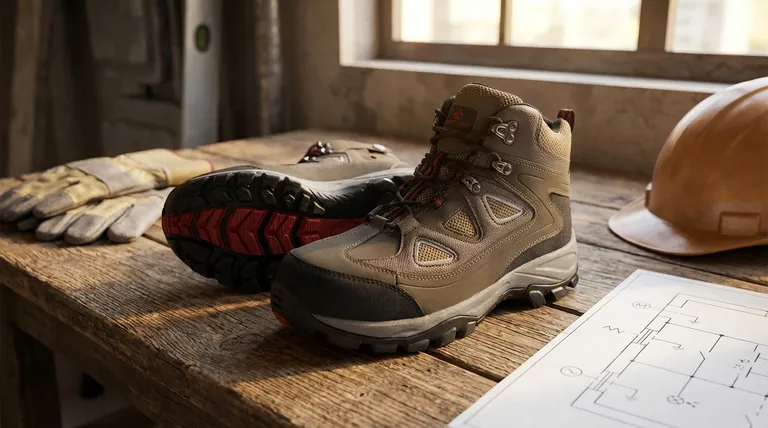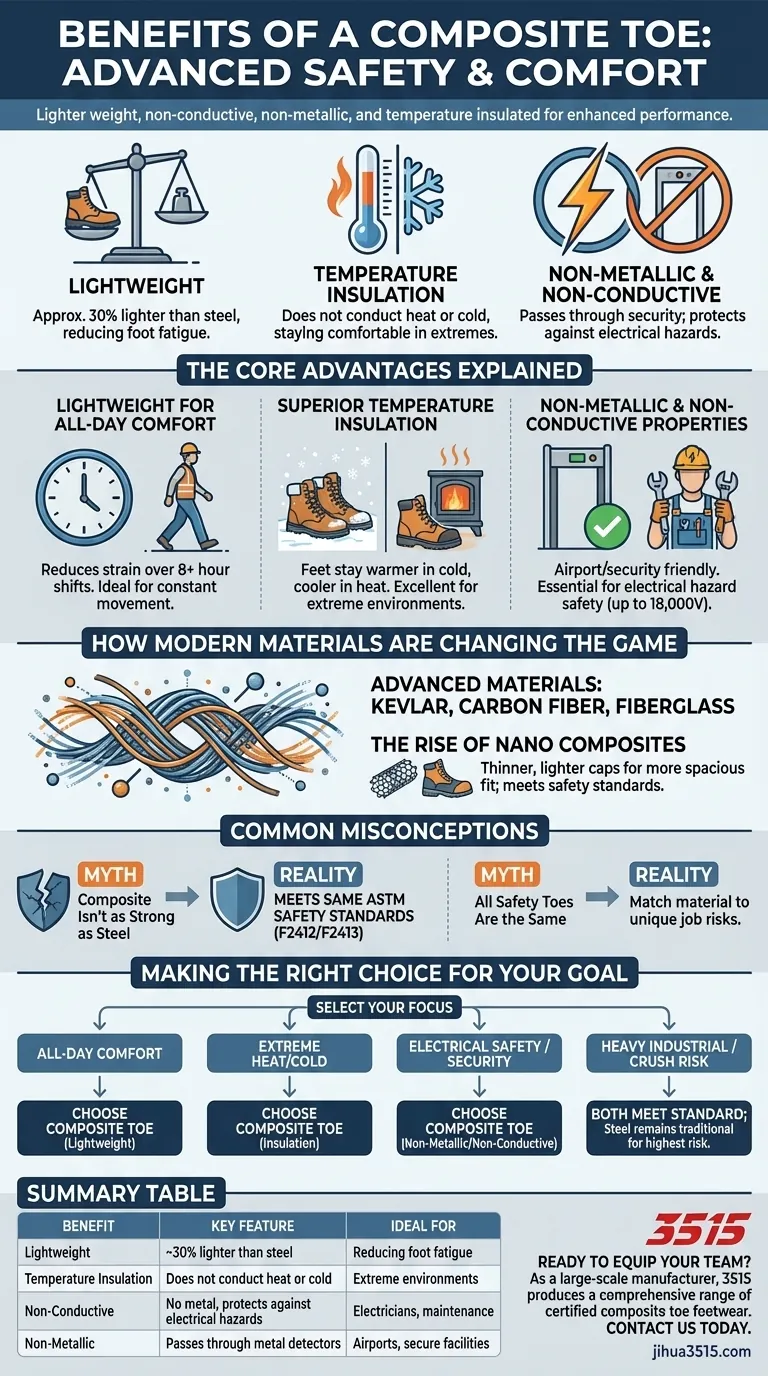The primary benefits of a composite toe are its lighter weight, its inability to conduct heat, cold, or electricity, and the convenience of being non-metallic. These attributes make composite toe footwear significantly more comfortable for long shifts and essential for certain specialized work environments.
While traditional steel toes are known for protection, the core advantage of a composite toe lies in its advanced materials. It delivers certified safety without the weight and conductivity of metal, enhancing comfort and suitability for a wider range of jobs.

The Core Advantages Explained
To understand if a composite toe is right for you, it's essential to look at how each benefit translates to real-world performance. The advantages go far beyond simple material differences.
Lightweight for All-Day Comfort
A composite safety toe is approximately 30% lighter than a comparable steel toe.
While this may seem minor, the weight difference significantly reduces foot fatigue over an 8- or 12-hour workday. This makes composite toe boots a superior choice for workers who are constantly on their feet or cover long distances.
Superior Temperature Insulation
Composite materials do not conduct heat or cold effectively.
This is a major advantage for anyone working in extreme temperature environments. In cold weather, your feet stay warmer because the cap isn't drawing heat away. In high-heat conditions, the toe cap won't become uncomfortably hot like its metal counterpart.
Non-Metallic and Non-Conductive Properties
Being entirely free of metal provides two distinct and critical benefits.
First, for workers who must pass through metal detectors—such as those in airports, nuclear facilities, or secure government buildings—composite toes eliminate the hassle of removing footwear at security checkpoints.
Second, and more importantly, composite materials do not conduct electricity. This makes them an essential choice for electricians and maintenance workers who face potential electrical hazards. Some models are rated to protect against open circuits up to 18,000 volts in dry conditions.
How Modern Materials Are Changing the Game
The term "composite" refers to a range of non-metallic materials, each offering unique properties. The technology is constantly evolving to improve strength and reduce bulk.
Beyond Basic Plastic
Modern composite toes are crafted from advanced materials like Kevlar, carbon fiber, and fiberglass. These materials provide incredible strength and durability while maintaining a very low weight.
The Rise of Nano Composites
The latest innovation is the nano composite toe. By using carbon nanotubes, manufacturers can create safety caps that are thinner and lighter than ever before.
This technology allows for a more spacious and comfortable fit in the toe box, addressing a common complaint about bulky safety footwear without compromising on impact and compression standards.
Common Misconceptions
When choosing safety footwear, it's crucial to separate historical perceptions from modern realities.
Myth: Composite Isn't as Strong as Steel
This is the most common misconception. To be sold as safety footwear, both composite and steel toe caps must meet the exact same ASTM International safety standards (F2412/F2413) for impact and compression resistance.
While steel has a legacy of strength, modern composites made from carbon fiber or Kevlar are engineered to provide equivalent, certified protection for most industrial applications.
Myth: All Safety Toes Are the Same
The reality is that the type of toe cap is a feature designed for specific hazards. Choosing the right one is about matching the material's properties to the unique risks and demands of your job.
Making the Right Choice for Your Goal
Select your safety toe based on the primary demands of your workplace, not just on tradition.
- If your primary focus is all-day comfort and reducing fatigue: Choose a composite toe for its significantly lighter weight.
- If your primary focus is working in extreme heat or cold: Choose a composite toe for its superior temperature insulation.
- If your primary focus is electrical hazard safety or passing through metal detectors: A non-metallic composite toe is the essential and correct choice.
- If your primary focus is work in extremely heavy industrial or construction settings: Both steel and modern composites meet the standard, but steel remains a trusted, traditional option for the highest-risk crush environments.
By understanding these key benefits, you can confidently select the safety footwear that truly supports your specific work demands.
Summary Table:
| Benefit | Key Feature | Ideal For |
|---|---|---|
| Lightweight | ~30% lighter than steel | Reducing foot fatigue on long shifts |
| Temperature Insulation | Does not conduct heat or cold | Extreme temperature environments |
| Non-Conductive | No metal, protects against electrical hazards | Electricians, maintenance workers |
| Non-Metallic | Passes through metal detectors | Airports, secure facilities |
Ready to equip your team with superior composite toe footwear?
As a large-scale manufacturer, 3515 produces a comprehensive range of safety boots and shoes for distributors, brand owners, and bulk clients. Our production capabilities encompass all types of composite toe footwear, ensuring certified protection, enhanced comfort, and durability tailored to your specific industry needs.
Contact us today to discuss your requirements and discover how we can deliver the perfect safety solution for your business.
Visual Guide

Related Products
- Safety Footwear Wholesale Manufacturer for Custom OEM/ODM Production
- Premium Flame-Retardant Waterproof Safety Boots and Shoes
- Premium KPU Injection Athletic Style Safety Shoes
- Wholesale Safety Footwear Manufacturer for Bulk & Custom OEM Orders
- Wholesale Customizable Safety Boots Durable & Protective Footwear Manufacturing
People Also Ask
- What are the differences between steel toe, composite toe, and alloy toe Wellington boots? Choose the Right Safety Toe for Your Job
- What do heavy duty boots do? Protect Your Feet in Demanding Work Environments
- What are OSHA approved shoes? Understanding the Correct Standards for Workplace Safety
- What cultural and environmental considerations are tied to wearing shoes indoors? Balance Hygiene, Tradition, and Foot Health
- Is safety-toe as good as steel toe? Choose the Right Protection for Your Job



















